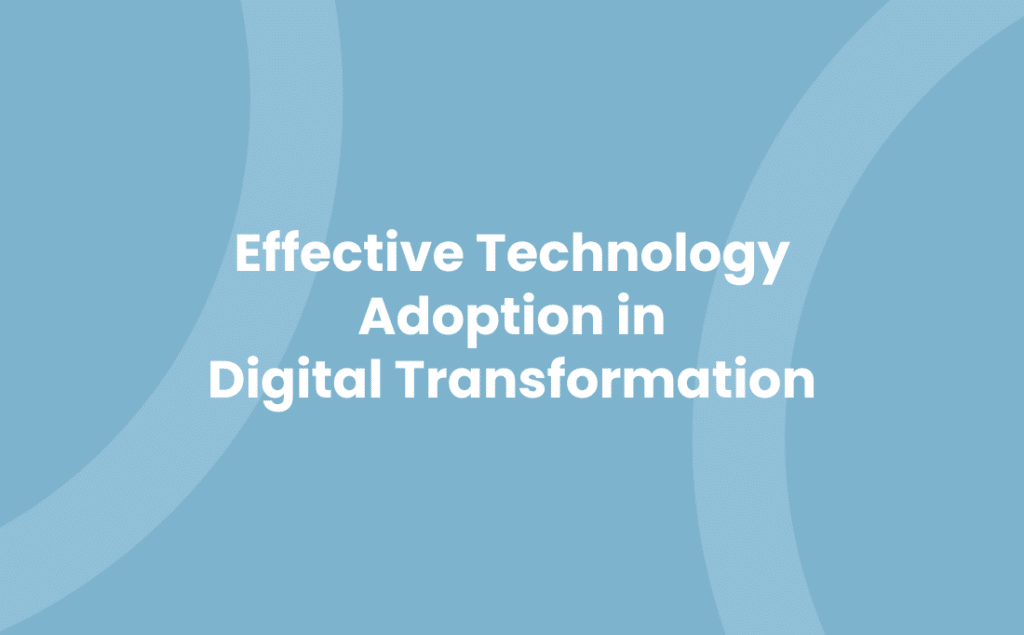Digital transformation isn’t just a buzzword; it’s a necessary leap you need to take in today’s tech-driven world. If you’re still on the fence, consider this your wake-up call. The digital landscape is evolving at warp speed, and businesses that fail to adapt risk being left behind.
Don’t panic just yet. This article is your roadmap to navigating the complex world of digital transformation technology adoption. We’ll demystify the process, breaking it down into manageable steps that’ll help you stay ahead of the curve.
So, are you ready to take the plunge? Let’s dive in and explore how digital transformation can revolutionise your business operations, improve customer experience, and ultimately, drive your bottom line.
Understanding Digital Transformation Technology Adoption
Grasping the adoption of digital transformation technology entails recognising the prominent role that shifting to a digital framework plays in your business. This shift points out the use of digital technology in all aspects of your business operations. With the constant evolution of technology, adopting digital transformation isn’t just a one-off process; it’s a continuous, dynamic undertaking. Now, let’s get into the finer details.
First, evaluate your organisation’s digital maturity. Understanding where your British SME stands forms the basis of your digital journey. From here, set achievable targets to increase your company’s digital fluency. Targets help guide the metamorphosis to becoming digitally focused.
Next, fostering digital pretence in your team is crucial. You can’t expect to achieve your digital objectives without a digitally savvy team. Encourage your team to embrace tech adoption. Offering training and education opportunities not only enhances digital skills, but also fosters a culture that values innovation.
Your customer experience also matters as it plays a significant role in digital transformation tech adoption. Integrate your digital operations with traditional ones, creating a seamless, user-friendly experience. Use customer feedback to fine-tune this integration ensuring a co-created value proposition.
Lastly, remain adaptable and flexible. The tech sphere changes routinely, so your approach to digital transformation technology needs to change too. Keep an eye on technology trends to stay ahead, maximising your business’s digital potential.
The Process of Technology Adoption in Digital Transformation
Through an intricate walk, you’ll delve headfirst into the adoption of digital transformation technology. Digital adoption doesn’t arrive as a lightning bolt; rather, it spreads like a forest, encompassing every aspect of the business landscape.
A crucial step lies in pinpointing digital resources. Pinpoint systems, software, or tools that truly align with your company’s ethos. For instance, a firm seeking to enhance customer experiences may find chatbots a worthwhile investment.
Next, a comprehensive audit of digital maturity often reveals much. Gauge your firm’s readiness for tech adoption. Consider your existing infrastructure, employee know-how, and past digital ventures.
Staff training forms the backbone of digital transformation. Equip your team to harness new technologies by offering regular training and professional development opportunities. A proficient team, adept in digital operations, proves a formidable force in technology adoption.
Integration of the newfound digital operations with traditional methodologies demands attention. Strive not for a digital knockout but for a harmonious union of old and new. A balanced portfolio of digital and conventional procedures offers an edge, creating a seamless customer experience.
Keeping a finger on the pulse of technological trends proves advantageous. Remain adaptable, recognise shifts in digital landscapes, and pivot accordingly. An organisation agile in strategy reaps maximum benefits from tech adoption.
Lastly, continual assessment ensures your ride through technology adoption remains on the track. Regularly appraise your digital evolution, tweak approaches where necessary, and encourage an environment open to change.
Remember, the quest for tech adoption in digital transformation paves the way for a business’s future. As you strive to remain competitive amidst evolving tech trends, remember – it’s a marathon, not a sprint. Entrepreneurs who embrace this unique journey often emerge successful, setting new trends in the world of digital transformation technology.
Case Studies on Successful Technology Adoption in Digital Transformation
Dive into a number of instances where business embraced digital transformation technology. Look at the successful implementation strategies they adopted. These case studies not only offer insights into tech adoption but also spell out the manifold benefits of digital transformation.
1. Coca-Cola’s Digital Refresh
Coca-Cola stands as an epitome of successful digital transformation technology adoption. Motivated by a strong desire to improve consumer engagement, the brand launched a digital marketing platform. Its charming ‘Share a Coke’ campaign resulted in a significant boost in sales, showcasing a textbook example of digital transformation in progress.
2. General Electric’s Industrial Internet
In an bold endeavour to transform itself into a digital industrial company, General Electric decided on accelerating digital transformation. GE introduced the Industrial Internet, a cloud-based platform that allows industries to connect machines, data, and people. This initiative solidified GE’s position in the tech landscape and led to substantial efficiency gains.
3. Nestle’s Digital Acceleration Team (DAT)
Nestle implemented digital transformation to stay abreast of changing consumer habits. The company set up the Digital Acceleration Team (DAT) to monitor online conversations about the brand, analyse data and run social campaigns. The insights gained by DAT facilitated Nestlé in tailoring their products and customer communication models. This move is a great example of tech adoption in digital transformation, enhancing customer relations and building brand loyalty.
4. DBS Bank’s Digibank Initiative
With an objective to transform into a digital bank, DBS Bank, Singapore, launched Digibank, a mobile app offering a comprehensive range of banking services. This innovative move not only attracted a younger demographic but also slashed operational costs by 90%. Undoubtedly, the Digibank initiative speaks volumes about how digital transformation technology can streamline business operations and cut costs.
These thrilling stories of success underline the crucial role of tech adoption in digital transformations. Keep in mind, however, that every company is unique. Their objectives, capabilities and resources dictate the best course of action for them. It’s essential, therefore, for a business to discern what works best for them based on these important factors.
Barriers to Digital Transformation Technology Adoption
Transitioning to digital modes of operation introduces exciting prospects for increased productivity, cost reduction, and improved consumer engagement. However, as adoption of tech in digital transformation unfolds, certain challenges obstruct the smooth transition. Understanding these barriers facilitates planning and pacing of tech integration into business processes, ensuring hurdles are tackled effectively.
Foremost, resistance to change emerges as a significant hindrance. Employees, accustomed to traditional workflows, often exhibit reluctance towards new tech-enabled processes. This scenario calls for comprehensive training initiatives. Alongside this, ensuring clear communication about the benefits of digital transition can boost acceptance and applicability.
Next, digital readiness also becomes a critical limiting factor. In simpler terms, organisations may lack the necessary infrastructure, resources, or expertise to support tech adoption in digital transformation. This means installing the required hardware and software, fostering an environment open to digital innovation, and training employees to skilfully manage technology becomes critical.
Further, aligning digital transformation with the overall business strategy can pose challenges. Without a clear roadmap on embedding tech-enabled processes into existing workflows, achieving digital transformation can become a complex task. For instance, optimising web inventory for e-commerce requires the alignment of tech tools to inventory management, supply chain, and consumer service.
Lastly, concerns around security and data privacy can be significant roadblocks. With increased reliance on digital infrastructures, vulnerabilities to cyber-attacks and data breaches rise. Establishing robust cybersecurity protocols and regular audits of security measures are essential to mitigate these risks.
In sum, though digital transformation offers a myriad of benefits, facing its challenges head-on ensures your business can effectively leverage the potential of tech adoption to meet your unique objectives.
How to Overcome Adoption Challenges
Breaking down the barriers to digital transformation technology can seem like a daunting task. Overcoming these challenges can lead to immense rewards, with new tech adoption setting the stage for an innovative, streamlined approach to business. Below, you’ll discover the primary strategies for tackling these tech adoption challenges.
- Promote a Digital Culture: Encourage digital mindfulness, pushing your team to think not just about how to use technology, but also why and when. Infuse digital culture into your business. The more comfortable employees are with new technology, the smoother your transition to a digital landscape will be.
- Invest in Training: Equip your staff with the digital skills they need. Learning new technology might initially seem challenging, particularly for employees more experienced with traditional methods. Provide ongoing training, using real-life examples to ensure the material is relatable.
- Make Gradual Changes: Rather than adopting all new technology at once, introduce it gradually. With this approach, you counter resistance to sudden, dramatic change and allow your team to adapt at a reasonable pace.
- Collaborate With Experts: Partner with experienced professionals who understand your business requirements and the intricacies of digital transformation technology. They’ll guide you in choosing the most suitable and effective tech for your specific needs.
- Strengthen Security Measures: Address concerns regarding data protection and privacy early by implementing stringent security measures. Transparency about these safeguards eases staff’s discomfort and reassures them about the safety of their digital work environment.
- Regular Evaluation: Make sure you frequently assess your tech adoption strategies. Adapt and refine them as your digital journey evolves, allowing your business to stay agile and resilient in a dynamic digital landscape.
Conclusion
You’ve seen the importance of digital transformation and the pivotal role technology adoption plays in it. It’s not just about keeping pace with the digital age, but also about optimising your operations, boosting productivity, and staying competitive. It’s clear that the journey isn’t without hurdles. Resistance to change, security concerns, and alignment with business strategy can all pose significant challenges. But they’re not insurmountable. With the right approach, fostering a digital culture, investing in education, and making gradual changes can help you navigate these barriers. And remember, it’s not a one-time effort. Keeping abreast of tech trends and regularly re-evaluating your strategies is key to staying agile in this rapidly evolving digital landscape. So, embrace the digital transformation with confidence and let it be the catalyst for your business’s growth and success.


